Table of Contents
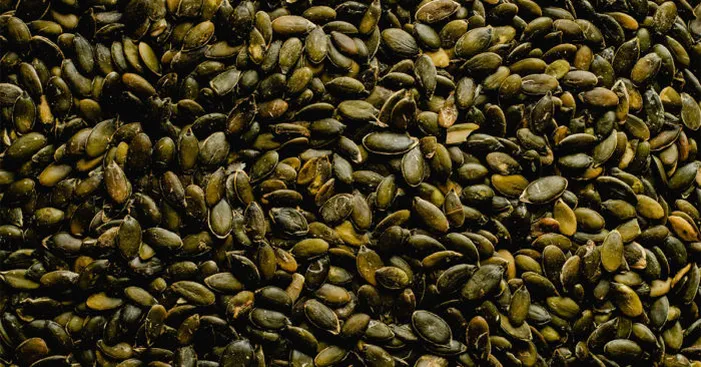
Pumpkinseed is extracted from different species of squash.
To be specific, these seeds come from the species called “Cucurbita pepo” commonly referred to as pumpkin.
This vegetable is an essential element in Mexican and South American cuisines.
Also, many other cuisines use it in both savory and sweet recipes such as the Middle East and Afghan cuisines.
In this article, you will discover everything you need to know about the pumpkinseed, how to eat it, its nutritional value, health benefits, possible side effects, and tips on how to buy and store it!
History of pumpkins:
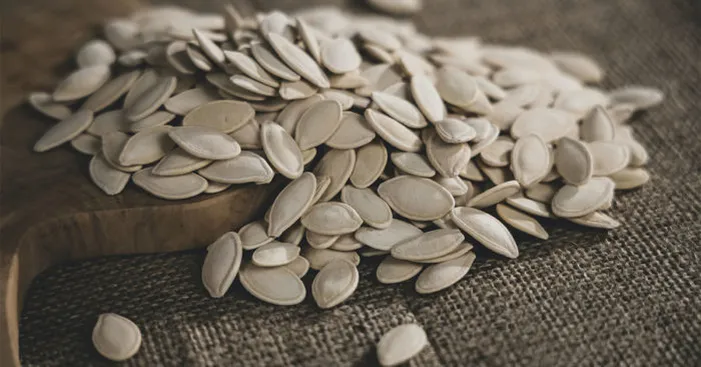
The first cultivation of squash dates back 10,000 years ago which explains its reputation throughout the world.
In fact, Amerindians and mainly the Algonquians and Menominis were the first people who planted pumpkins.
They consumed pumpkins for their delicious taste and made remedies using pumpkinseed to treat urinary diseases.
In addition, the Cherokees used pumpkin and pumpkinseed to treat enuresis for children (bedwetting).
Several years after that, it was these Native Americans who introduced the seeds to European settlers.
English settlers then, made their own recipes by crushing pumpkinseeds and mix them with milk or honey as a deworming remedy.
After the genocide of Native Americans, the new Americans of the United States used pumpkinseed in pharmaceutical drugs to treat different types of diseases.
Most of these diseases are related to parasites in the digestive and urinary systems which pumpkinseed iseffective against.
Nowadays, doctors prescribe pumpkinseed to treat enuresis and bladder irritation.
The difference between raw and toasted pumpkinseed:
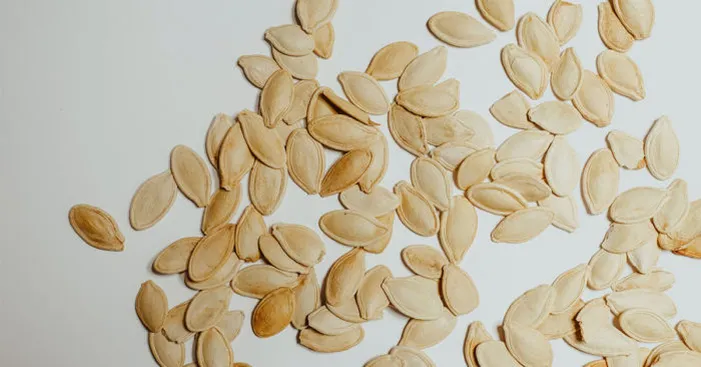
You can consume pumpkinseed raw or toasted however it doesn’t have the same nutrients.
In fact, raw pumpkinseed contain phytic acid, which can reduce the body’s ability to absorb nutrients from food.
Once toasted, the amount of phytic acid in pumpkinseed is reduced.
Another useful method to reduce phytic acid is to soak pumpkinseed in water for 30 minutes.
The method of roasting pumpkinseed also affects the number of calories.
For instance, roasting them in butter or olive oil increases their calorie values.
During the roasting process and unlike most roasted nuts or seeds, pumpkinseed is usually not salted.
Thus, roasted pumpkinseed with no salt, butter, or olive oil are much healthier than raw pumpkinseeds.
Pumpkinseed nutritional data:
Pumpkinseed calories:
These are the nutritional data for 1oz (30g) of dried pumpkinseed:
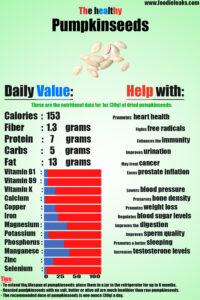
- Calories: 153
- Fat: 13g
- Protein: 7g
- Fibers: 1.3g
- Carbs: 5g
- Vitamin B1: 6%
- Vitamin B9: 6%
- Vitamin K: 20%
- Calcium: 2%
- Copper: 20%
- Iron: 25%
- Magnesium: 40%
- Potassium: 8%
- Phosphorus: 35%
- Manganese:44%
- Zinc: 16%
- Selenium: 4%
Benefits of pumpkinseed:
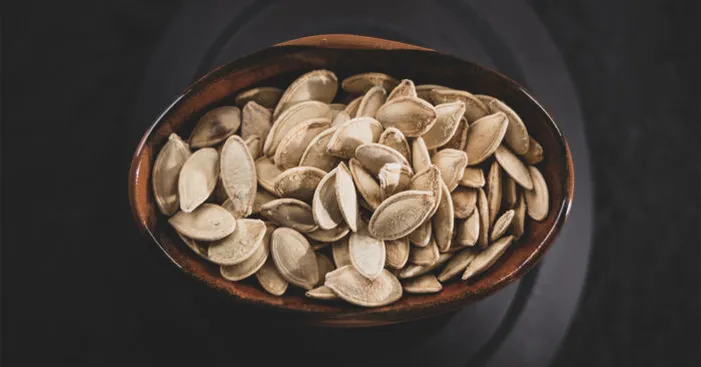
Powerful antioxidants:
Pumpkinseed is very rich in antioxidants including carotenoids and vitamin A.
These antioxidants have the potential to fight free radicals in the body which is the source of most diseases.
Also, consuming pumpkinseed enhances the body’s immunity and promote the healing of corrupt cells.
Improve bladder and prostate health:
There are several studies shows that eating pumpkinseed helps:
- Relieve the symptoms associated with extensive bladder activity and improve urination for infected people.
- Ease the symptoms related to prostate inflation (prostate plasia), where the prostate gland swells and interfere with the urination process.
Reduce the risk of cancer:
By including more pumpkinseed in your diet you will reduce the risk of any type of cancer including:
- Colon cancer.
- Stomach cancer.
- Lung cancer.
- Breast cancer.
Many studies show the effectiveness of pumpkinseed to reduce the risk of cancer thanks to their powerful antioxidants.
Other studies show that eating pumpkinseed may help the healing process of breast cancer.
In addition, pumpkinseed not only help in the healing stage of cancer but also slows the growth of cancerous cells.
Rich in magnesium:
The American heart association recommends eating 1oz (28g) of pumpkinseed daily to get the most benefits.
That may seem like a small dose, but it contains about 40% of our daily need for magnesium.
Magnesium plays many essential roles in our body as it helps:
- Regulate blood pressure.
- Regulate blood sugar levels.
- Preserving bone density.
- Reduce the risk of heart disease.
This is very beneficial for people who deal with blood pressure issues, diabetes, and cardiovascular problems.
Regulates blood sugar levels:
Few preliminary studies show how regular consumption of pumpkinseed can regulate blood sugar levels.
Even though more researches need to be done on this topic.
However, a huge part of these beneficial properties is linked with the abundance of magnesium in pumpkinseed.
Improves heart health:
Thanks to its content in saturated fats and minerals, pumpkinseed contribute to the well-being of our hearts.
In fact, one ounce of the seeds provides 15%, 40%, and 12% of our daily need in zinc, magnesium, and saturated fats.
It also provides boosts of vitamin B6 and B9 which all combined play a key role in maintaining heart health.
Some studies show that eating pumpkinseed reduces bad cholesterol and expand blood vessels thanks to their enzyme content.
As a result, our blood vessels expand and have less bad cholesterol which smoothens blood circulation.
Good source of fibers:
Pumpkin and pumpkinseed supply our bodies with dietary fibers to help meet our daily needs.
We don’t digest fibers but they have many benefits such as:
- Reducing the risk of diabetes and obesity.
- Improving the digestion process.
- Reducing the risks of heart strokes.
Improves sperm quality:
Pumpkinseed contain many beneficial nutrients and are certainly a good source of zinc.
Several studies show the effectiveness of zinc in improving the quality of sperm and the overall reproductive system of men.
This is because zinc provides good protection for the sperm against damages from autoimmune diseases or chemotherapy.
Also, eating pumpkinseed will supply our bodies with zinc which improves testosterone levels.
Improves the quality of sleep:
Did you know that the recommended daily dose of pumpkinseed provides up to 15% of our need for protein?
Those proteins in pumpkinseed contain certain kinds of amino acids which can improve sleep quality.
Another benefit of zinc in pumpkinseed is that it promotes the production of melatonin which regulates sleep cycles.
By snacking on a handful of pumpkinseed right before you sleep, you will definitely have a better sleep.
Pumpkinseed: from pumpkin to seeds

Pumpkinseeds are really easy to collect and roast!
Even if you rarely buy large pumpkins to cook with, this will make you think twice before throwing away the insides of your Halloween pumpkin!
To get your own raw and dry pumpkinseeds:
- Cut the top part of the pumpkin just enough to get a tablespoon inside easily.
- Use a tablespoon to take out all the insides of the pumpkin then put them in a bowl.
- Pour the seeds you collected into a sifter and wash them with water.
- Put the seeds on a piece of clothing and spread them so that no seed is above the other (if you find some remaining fibers make sure you take them away).
- Using a second piece of clothing, start petting on the seeds from the top to dry them as much as possible.
- Place the seeds in an aired space for 2 hours to ensure they are not moist anymore.
In case you want to roast your pumpkinseeds more healthily, here’s how to do it:
- Preheat your oven to 350°F for 10 minutes.
- Now, get a tray and place a baking sheet or aluminum foil on it.
- Put your dried pumpkinseeds on the tray and spread them evenly.
- Roast the seeds for 30 minutes and make sure you stir them every 10 minutes.
- Once the pumpkinseeds start getting a golden color, they are done.
- Take them out of the oven and put them on a tray to allow them to cool down.
Notice that we didn’t use salt or oils in the roasting process to ensure the healthiness of seeds.
Now you have your homemade pumpkinseeds which you can use in many different ways.
Using pumpkinseed:
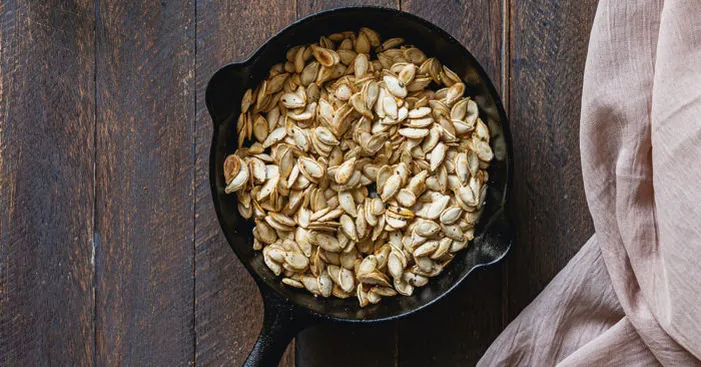
As always, we collected a few ideas and tips for you to broaden your list of recipes with pumpkinseed.
Whether roasted or raw, pumpkinseed combines well with both savory and sweet dishes.
People use them in appetizers and desserts for their flavor and decorative aspect.
Here is our list of the different uses of pumpkinseed:
- The first easy uses are either to snack on them or add them to your cereal alongside almonds, hazelnuts, pistachios…
- Added to salad: whether it’s a mixed salad, beet salad, tomato salad, or any type of salad.
- In your cheese board, as they combine very well with goat cheese.
- Incorporate them in sauces or dressings, just make sure you grind them or make them into a puree.
- In baking recipes as you can integrate them directly into the bread dough.
- Sprinkle them on a pie, cake, quiche, soup, toast …
- Add them to your risotto recipe.
- Add them to any vegetable dish to enhance the benefits and the flavor.
- You can blend pumpkin seeds into a powder then add it to your drinks such as smoothies, hot chocolate, milk, tea…
- In baking recipes such as cookies, muffins, cakes, waffles…
- With fruity or chocolate desserts.
- To decorate your dishes with bright green seeds that not just add to the vibrancy of the plate but also taste delicious.
Precautions you need to know before you eat pumpkinseed:

As with most other types of food, pumpkinseed is very beneficial but only when we eat it in moderate amounts.
There are certain groups of people who may need to stay away from pumpkinseed including:
Infants:
These seeds are a very good source of protein and iron and they taste very appealing especially to kids.
However being full of fatty acids and fibers, pumpkin seeds are not good for infants.
This is because such a combination of nutrients may cause stomach cramps, vomiting, or diarrhea.
Stomach ache:
When we consume a large number of pumpkin seeds, we may risk upsetting our stomachs.
This is due to the big amount of oils these seeds contain which may cause pain in the stomach.
Also, it is probably not good for people who take urine-generating drugs because pumpkinseed also stimulate urination.
The combination of pumpkinseed and urine-generating drugs may risk affecting the balance of minerals in the body.
People with low blood pressure:
Pumpkinseed is a great source of magnesium which lowers blood pressure.
This may be beneficial for people with high blood pressure but it is not the case for people with hypotension.
If the person is using high or low blood pressure medications, pumpkin seeds may interfere and counter or aggravate the effect of these drugs.
Because of that, for those who take blood pressure medications, it is best to consult a doctor before consuming pumpkin seeds.
May lack nutrients:
If you don’t eat pumpkinseed the right way, you may risk losing many nutrients.
Crispy toasted pumpkin seeds are devoid of vitamin B6, vitamin B12, and Vitamin C.
Also, make sure you chew pumpkin seeds well before swallowing.
This is because the stomach cannot break the seeds entirely and good digestion always starts from good chewing.
Storing pumpkinseed:

Like most types of seeds, pumpkinseed need to be kept in a dark and not moist place.
Pumpkin seeds specifically tend to go rancid very rapidly due to their high oil content.
You can use a glass jar to store pumpkin seeds and then place them in the pantry away from light.
To extend its lifespan, you may place the jar in the refrigerator to keep the seeds for up to 6 months.
You can also freeze pumpkin seeds in an airtight freezing container for up to 2 years.
If you don’t store them properly, these seeds may go rancid in a couple of weeks.
Buying pumpkinseed:
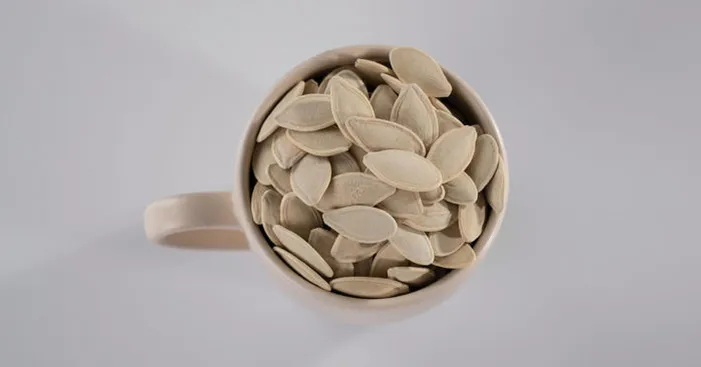
Now as you may know you can easily find pumpkinseed raw or roasted in grocery stores.
You may even want to get pumpkin seeds from the vegetable yourself.
These are our tips for picking the best pumpkin seeds:
- If you are buying roasted pumpkin seeds, feel free to taste a seed and ensure it’s not rancid or old.
- It’s easy to know the freshness of these seeds as old roasted pumpkin seeds have a distinguishing unpleasant taste.
- If you are buying raw pumpkin seeds you need to make sure they are well-dried and not chewy.
- If you use this delicious vegetable in your cuisine, you can get your seeds from the pumpkins you buy.
Experts recommend that large pumpkins, not necessarily heavy, contain more seeds.
Don’t forget that you need to dry the seeds before you roast them.
